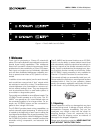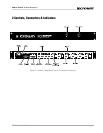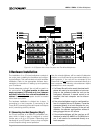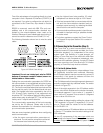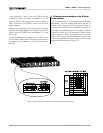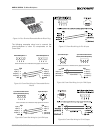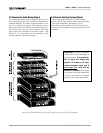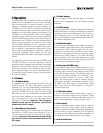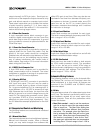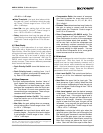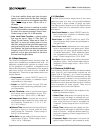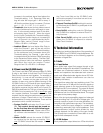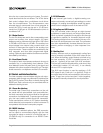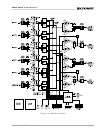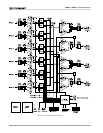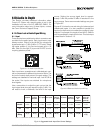
Page 16 IQ–AMB-5 / IQ–SMX-6
Reference Manual
AMB-5 / SMX-6 IQ Mixer/Multiplexer
output channel) via RCA pin jacks. Each input en-
ters the mix of the respective output channel at unity
gain, and without manual or computer input control.
These stack inputs allow you to multiply the number
of audio inputs by stacking 2, 3, or more units to
build a larger mixer. See section 5.1.4 for more infor-
mation about forming larger mixers.
4.1.10 Crown Bus Connector
A 4-pin removable barrier block connector is pro-
vided for digital communication via the Crown Bus
serial data loop to other IQ components. A ground
lug is provided to connect an optional shield for the
Crown Bus input.
4.1.11 Crown Bus Ground Connector
This chassis ground stud is provided to connect an
optional shield for the Crown Bus cable. Only the
shield of the input cable should be connected.
Shielded wire will reduce the total distance a Crown
Bus loop can be run, but shielding may be neces-
sary to reduce interference with certain kinds of
audio cables. See section 5.5 for more information
about wiring the Crown Bus.
4.1.12 RS232 Serial Computer Port
A 9-pin DB9 serial computer port is provided for
direct communication with a computer. The mixer/
multiplexer is capable of serving as a system inter-
face for up to 20 IQ mixer/multiplexers.
4.1.13 Sensing AUX Port
A TB-3M type “mini-XLR” connector is provided for
AUX input and output. This port may be used to
provide a control signal or sense a control signal.
Pin 1 is ground reference. Pin 2 is a sensing input. A
signal between +5 to +30 VDC is sensed as a logic
high. Because the circuit floats, the input line must
be tied to ground or a control voltage source to be
used. Pin 3 is output under processor control. When
on, it provides 10 VDC at 16 ma, and when off, it is
effectively an open circuit (high impedance). Sec-
tion 6.2 describes example applications for the AUX
port.
4.2 Computerized Control and Monitoring
The following features are controlled and monitored
via IQ software.
4.2.1 Manual/Auto Mode
This feature switches the mixer/multiplexer between
Manual and Automatic modes. When in Manual
mode, you may make changes from software that
affect VCA gain in real time. Gain may also be ma-
nipulated in real time from alternate third-party con-
trol systems or devices. In manual mode, once VCA
gains are set via the PC (or control device) the
processor maintains those settings until it receives
an instruction to change.
4.2.2 Input Level Monitors
Audio level monitors are provided for each input.
The level is sensed between the preamp and VCA's,
with a range of –40 to +25 dBu.
4.2.3 Output Level Monitors
Audio level monitors are provided for each output.
The level is sensed at each output mix bus with a
range of –40 to +25 dBu.
4.2.4 Bus Output Relays
Audio bus outputs can be switched on and off with
software controlled isolation relays.
4.2.5 VCA Gain Controls
Each input may be routed to either or both outputs
by VCAs under processor control. The processor
may, in turn, be set up to control VCAs using on
board automatic intelligence or may be controlled in
real time manually from software. The VCAs offer a
control range of –100 to +25 dB.
Automatic Mixing Features
The following features make up the Automatic Mix-
ing Feature Set, and are only functional when the
mixer/multiplexer is in Auto mode. All features are
common to the IQ–AMB-5 and IQ–SMX-6 unless
otherwise stated.
4.2.6 Gate
The gate feature shuts off or attenuates inputs when
not in use. This feature is particularly useful to pre-
vent feedback caused by too many open micro-
phone channels. There are four parameters which
control this feature:
• Max Gain control: used to set the maximum
gain for an input to one of the two outputs when
Auto is turned on. The Max Gain setting has
different effects when different Auto functions
are active. For example, when the Gate func-
tion is activated the Max Gain will be the “gate
open” level. When then Input Compressor/Lim-
iter function is activated, it acts as the “limit,”
the upper gain achieved when no compression
is taking place.* Control range is from –100 to



